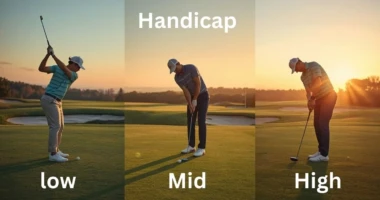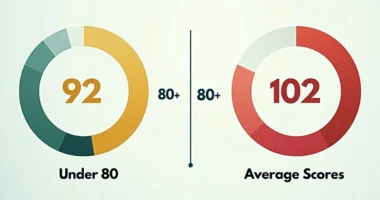If you’re new to golf or still working on lowering your scores, you’ve probably asked yourself: “What is a good golf score for a high handicapper?” Don’t worry, you’re not alone. Many golfers start with a higher handicap, and figuring out what counts as a “good” score can feel confusing.
The truth is, a “good golf score” depends on your skill level, experience, and consistency. For high handicappers, progress isn’t about shooting under par; it’s about setting realistic goals, celebrating improvements, and enjoying the game.
Understanding the High Handicap in Golf
Before we define a good score, let’s quickly understand what “high handicap” means.
- A handicap is a number that represents a golfer’s skill level.
- The lower the handicap, the better the golfer.
- A high handicapper usually has a handicap of 20 or above.
For example:
- Handicap 20–25: Beginner to intermediate level
- Handicap 25–36: Still learning the game, working on consistency
High handicappers often shoot between 95 and 120 strokes on 18 holes.
What Is Considered a Good Score for High Handicappers?
A “good” score is not about perfection. It’s about steady improvement. Here’s a breakdown:
- Breaking 120: A common first goal for many beginners.
- Breaking 110: A good sign of progress for high handicappers.
- Breaking 100: Often considered the benchmark of a “decent” golfer.
- Scoring in the 90s: A very good achievement for a high handicapper.
So, if you’re a high handicapper and you’re scoring around 100–110, you’re doing well. Anything below 100 is impressive for this skill range.
Why Scoring Goals Matters?
Setting score goals helps you:
- Stay motivated during practice
- Track progress over time
- Build confidence with small wins
- Avoid comparing yourself unfairly to professionals
Remember, golf is a game of patience. Your good score is not Tiger Woods’ good score.
Factors That Influence a High Handicapper’s Score
Several things affect what’s considered a “good” score for you:
1. Course Difficulty
Some courses are tougher with narrow fairways, bunkers, and water hazards. Shooting 105 on a hard course might be better than shooting 98 on an easy one.
2. Weather Conditions
Wind, rain, and heat all impact scoring.
3. Equipment
The right clubs, properly fitted, can make a big difference.
4. Experience Level
A player with 6 months of practice has different expectations than someone playing for 6 years.
5. Physical Fitness
Endurance, strength, and flexibility all influence your ability to maintain form throughout a round.
Common Score Benchmarks for High Handicappers
Here’s a quick look at realistic goals:
| Handicap Range | Typical Score (18 Holes) | “Good” Score to Aim For |
| 20–25 | 95–105 | Breaking 95 |
| 25–30 | 100–115 | Breaking 100–105 |
| 30–36+ | 110–125+ | Breaking 110–115 |
Breaking 100: The Magic Number for Many Golfers
For most high handicappers, breaking 100 is the ultimate milestone. Why? Because it represents:
- Consistency in hitting fairways and greens
- Fewer penalty strokes
- Better putting control
A round under 100 shows that you’re transitioning from a beginner to an intermediate golfer.
Pro tip: If you shoot a bogey (1 over par) on every hole, you’ll score 90. That means you don’t need birdies, just consistent bogeys and avoiding big blow-up holes.

Tips for Achieving a Good Score as a High Handicapper
Improving your score isn’t about big swings—it’s about small, consistent changes.
1. Focus on Short Game
Putting and chipping make up nearly half your strokes. Practice from 3–6 feet regularly.
2. Play Smart, Not Aggressive
Avoid risky shots. Aim for the fairway instead of always going for maximum distance.
3. Master Course Management
Know when to use irons instead of drivers. Sometimes laying up is smarter.
4. Limit Penalty Strokes
Avoid water hazards and out-of-bounds areas. These add unnecessary strokes.
5. Build Consistency
Hitting straight, moderate shots is better than swinging hard and slicing.
6. Track Your Progress
Use scorecards or golf apps to monitor improvement.
Mental Side of Golf: Defining Your Own “Good” Score
Golf is as much a mental game as it is physical. For high handicappers, frustration is common. The key is to:
- Celebrate small wins (like fewer three-putts).
- Stay patient, scores drop with time.
- Avoid comparing yourself to low-handicap players.
- Focus on enjoying the round, not just the score.
The Role of Practice Frequency
- One overlooked factor is how often you practice.
- Practicing once a week may maintain your skills.
- Practicing two to three times a week accelerates improvement.
- Even short 20-minute putting sessions at home can lower scores dramatically.
Consistency beats intensity. Regular, smaller practice sessions are better than rare, long ones.
Technology and Tools That Can Help High Handicappers
Golfers today have access to tools that make improvement easier:
- Golf GPS Devices: Track distances and avoid hazards.
- Launch Monitors: Measure swing speed, ball flight, and accuracy.
- Golf Apps: Record scores, analyze stats, and set goals.
- Training Aids: Putting mats, swing trainers, and alignment sticks.
These tools give feedback that helps high handicappers improve more strategically.
High Handicapper Success Stories
- John, Handicap 32 → 24 in 1 Year: Focused on the short game and broke 100 consistently.
- Maria, Handicap 28 → 20 in 18 Months: Practiced weekly and invested in fitted clubs.
- Sam, Handicap 35 → 29 in 10 Months: Used a golf coach and tracking apps to identify weaknesses.
These examples prove that dedication pays off; improving your score is always possible.
FAQs
Q1: Is breaking 100 a good score for a high handicapper?
Yes, breaking 100 is a major milestone and considered very good for high handicappers.
Q2: How long does it take to lower your handicap?
It varies, but with regular practice, most players see improvements within 6–12 months.
Q3: Should high handicappers keep score?
Yes, tracking your score helps measure progress, but don’t let it control your enjoyment.
Q4: What is the average golf score for beginners?
Beginners usually score between 110–120 on 18 holes.
Q5: Do high handicappers need professional lessons?
Lessons can speed up progress, especially in fixing bad habits early.
Conclusion
For high handicappers, a “good golf score” isn’t about shooting under par—it’s about progress and consistency.
- Breaking 120 is a starting point.
- Breaking 110 is solid progress.
- Breaking 100 is a fantastic achievement.
The journey from high handicap to mid-level is built on patience, smart practice, and steady improvement.
Also, read this for more Information: What Is Considered a Good Score in Golf?





